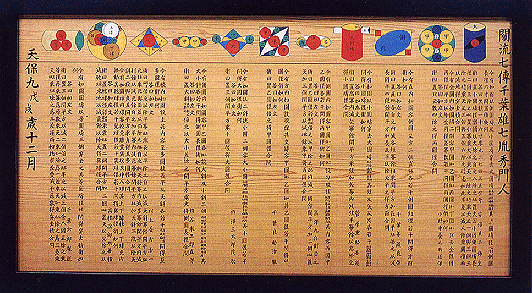
JAPANESE TEMPLE GEOMETRY

RESOURCES
TSUKIOKA YOSHITOSHI
(1839-1892)
GOSHO GOROZŌ BATTLING A SHADOW
Japanese Temple Geometry Board
Japanese temple geometry refers to the practice of carving verbal geometrical problems, theorems, and shapes into wooden tablets and presenting them as an offering at a shrine or temple. A Japanese math teacher, Hidetoshi Fukagawa, discovered the tablets in a library book while looking for interesting ways to teach his students. His interest in such a little known topic led to his quest throughout Japan to find and study the tablets. Around 900 of these tablets have survived the years and exist today.
In Japanese, this practice was called “sangaku” which translates as “mathematical tablet." The setting for the sangaku craze was the Edo period. During the Edo period Japan was ruled by a military dictatorship called the Tokugawa Shogunate (1603-1868). With very few exceptions, the Tokugawa government’s strict isolationist polices cut Japan off from contact with other countries between 1638 and 1854. During its isolation, Japan experienced a cultural renaissance. One of the many arts that flourished during the period was a unique type of Japanese mathematics that developed separately from western mathematics. Sangaku, therefore, are examples of a distinctly Japanese style of geometry.
Sangaku tablets were presented as offerings at Shinto Shrines and Buddhist temples, the two dominant religions of Japan. Buddhist temples were especially known as being centers of learning. But most of the tablets discovered came from Shinto shrines. This is most likely because the sangaku tradition followed in the steps of a practice common to Shinto of presenting decorated wooden tablets as offerings at religious sites. This practice served as a way for worshippers with few resources to make offerings to the Shinto gods. For example, if a worshipper wanted to offer a horse to the gods, he might choose to draw a picture of a horse on a piece of wood as an acceptable substitute.
The sangaku were placed under the roofs of these religious sites. Sometimes they were even fixed to the ceiling of a Shrine. The reason they were placed in the rafters or on the ceiling is unknown. Similarly, while the sangaku may resemble older ritual offerings on wooden tablets, their exact purpose remains a topic of speculation. Rothman claims the sangaku were either paying homage to Shinto spirits or they were a display of mathematical ability, challenging other worshippers to solve the math problems.
Each tablet was inscribed with a language called Kanbun. Kanbun is an old form of Japanese that consists of Chinese characters and grammar, accompanied by annotations to allow a Japanese reader to understand it. It was used for intellectual documents of the Edo period. The mathematical designs of the tablets varied, but many contained 3-dimensional objects and some had mathematical proofs. Most contained plane geometry, but some tablets displayed a type of mathematical calculation akin to algebra.
Sangaku were created by people from many classes and occupations, from samurai to merchants to farmers. The level of mathematical sophistication displayed on a tablet often corresponded to the education level of the person behind it. The designs on many tablets were done with the intent of attracting the mind of a non-mathematician; from their facedown placement on the ceiling, the tablets’ colorful designs were meant to inspire the intellect and issue challenges to other aspiring mathematicians.
It is speculated that Japan’s elite samurai class were primarily responsible for the creation and continuation of the sangaku. Following the ascent of the strict Tokugawa regime in 1603, the samurai were no longer needed in the military, and many took government posts that afforded them quite a bit more leisure time. Mathematics seems to have been a common pursuit of the samurai, and it was taught in the schools the samurai operated. While the practice of creating sangaku was widespread and supported by such elites, it would not last once Western mathematics arrived to Japan. Much like the role of the samurai class in Japanese society, the creation and popularity of sangaku faded away after the fall of the Tokugawa shogunate in 1868.
First posted 11/14/14
PRIMARY RESOURCES

Samurai

Samurai
Temple Geometry Boards
See below for enlargements.







